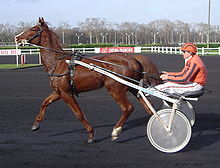French Trotter

|
|
| Other names | Trotteur français |
|---|---|
| Country of origin | France |
| Breed standards | |
The French Trotter is a horse breed from Normandy, France, developed in the 19th century from Norman horses with the addition of some English Thoroughbred and Norfolk Trotter blood.
Horses in France first began to be selectively bred for trotting races in the early to mid-1800s.The French Trotter developed primarily from Norman stock which was crossed with English Thoroughbred and half-bred hunter types, Norfolk Roadster, and some American Standardbred. The French Trotter is sometimes referred to as a Norman Trotter, due to the influence of the Old Norman horse on the breed's development.
The early Trotters were rather heavier and coarser than they are now, bearing a greater resemblance to their Normandy ancestors, but infusions of Thoroughbred blood have greatly refined the early significant influences on the development of the breed were by the stallion Young Rattler, foaled in 1811, who was by the Thoroughbred, Rattler, out of a mare with a high percentage of Norfolk Roadster blood.
Eventually five impressive Trotting lines were established by the stallions Conquerant, Lavater, Normand, Phaeton, and Fuchsia. Although there have been infusions of American Standardbred blood, the French Trotter has maintained the trotting gait (diagonal two beat) from the trotting line of the Standardbred, as opposed to the pacing gait (lateral two beat) an alternate line of the breed developed for speed.
After the continental trading blockade was raised, following the defeat of Napoleon Bonaparte at Waterloo in 1815, the market-wise Normandy breeders began to use their common but tough, all-purpose Norman stock as a foundation for breeding horses for general military use, both riding and light draught, and then, increasingly, to produce specialized horses of both types. Supported by the Administration of National Studs, they imported English Thoroughbreds and, just as importantly in the context of the trotting horse, English half-bred or hunter stallions, which were then unknown in France. They also imported the incomparable Norfolk Roadster the greatest trotter under saddle and in harness in the whole of Europe.
Chief among the early imports was the half-bred Young Rattler (foaled 1811), by the Thoroughbred Rattler, out of a mare with Norfolk Roadster connections. He is often called "the French Messenger", as his influence on the French Trotter was close to that of Messenger, the foundation sire of the American Standardbred, Young Rattler, together with other half-bred stallions and the essential contribution made by the Roadster, the Norfolk Phenomenon, improved the Norman mares in terms of conformation, movement, and scope, and prepared them for subsequent crossing with English Thoroughbreds.
...
Wikipedia
